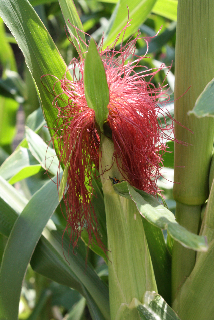
It has been several weeks since the last update, I have been busy with work, and Ruth and I took a trip to Miami Beach – more on the trip later. The garden is transforming, as the weather gets warmer or downright hot. The corn has been harvested and I must say it was a great success; the ears were small but tasty. The tomatoes are doing great. If you have not taken the opportunity to try one, you don’t know what you are missing. You can’t buy tomatoes like the ones from our garden. We have melons, potatoes, cucumbers and bean plants in the ground; jalapeno peppers are ready for picking and we planted a sunflower patch to add some color to the garden.
The compost bin is completed, so any weeds or vegetables can be placed in the composter. Remember, the composter only likes a plant-based diet, please no animal products. I have received several emails asking how to help. There are many things that you can do when you visit the garden, some suggestions are: pulling weeds around the fruit trees or out of the planting beds, watering the trees or planting beds if needed, checking for bugs, harvesting ripe tomatoes or other vegetables, or you can just relax and enjoy.
While Ruth and I were in Miami Beach we visited their community garden. The official name is the Joseph J. Vallari Victory Garden, or as they call it The Miami Beach Victory Garden. This community garden is dedicated to the memory of the men and women who were stationed in training camps in Miami Beach during WWII. Their garden is much more compact than ours. They have 20 plots that are about 4 feet by 6 feet. They run a membership where people are assigned individual planting beds and they also maintain a waiting list. The City provides lockers for the participants to use for their tools and other garden items. They have a rainwater collection system from the downspout from an adjacent building. Their approach is much different than ours but similar outcomes. We had the opportunity to meet a couple of the members, and they felt that the garden served as a meeting place and provided a sense of community in a very urban area. If you are interested in reading more, their website is http://www.miamibeachvictorygarden.blogspot.com/.
Gregg
The compost bin is completed, so any weeds or vegetables can be placed in the composter. Remember, the composter only likes a plant-based diet, please no animal products. I have received several emails asking how to help. There are many things that you can do when you visit the garden, some suggestions are: pulling weeds around the fruit trees or out of the planting beds, watering the trees or planting beds if needed, checking for bugs, harvesting ripe tomatoes or other vegetables, or you can just relax and enjoy.
While Ruth and I were in Miami Beach we visited their community garden. The official name is the Joseph J. Vallari Victory Garden, or as they call it The Miami Beach Victory Garden. This community garden is dedicated to the memory of the men and women who were stationed in training camps in Miami Beach during WWII. Their garden is much more compact than ours. They have 20 plots that are about 4 feet by 6 feet. They run a membership where people are assigned individual planting beds and they also maintain a waiting list. The City provides lockers for the participants to use for their tools and other garden items. They have a rainwater collection system from the downspout from an adjacent building. Their approach is much different than ours but similar outcomes. We had the opportunity to meet a couple of the members, and they felt that the garden served as a meeting place and provided a sense of community in a very urban area. If you are interested in reading more, their website is http://www.miamibeachvictorygarden.blogspot.com/.
Gregg
 RSS Feed
RSS Feed
